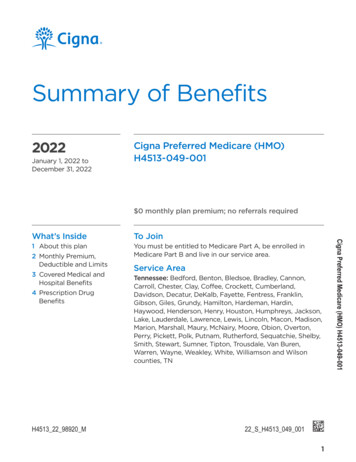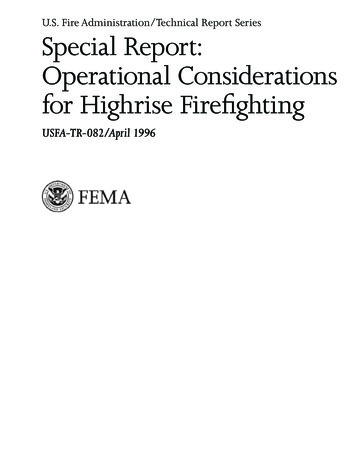
Transcription
U.S. Fire Administration/Technical Report SeriesHighrise OfficeBuilding FireOne Meridian PlazaPhiladelphia, PennsylvaniaUSFA-TR-049/February 1991
U.S. Fire Administration Fire Investigations ProgramThe U.S. Fire Administration develops reports on selected major fires throughout the country.The fires usually involve multiple deaths or a large loss of property. But the primary criterionfor deciding to do a report is whether it will result in significant “lessons learned.” In somecases these lessons bring to light new knowledge about fire--the effect of building construction orcontents, human behavior in fire, etc. In other cases, the lessons are not new but are serious enoughto highlight once again, with yet another fire tragedy report. In some cases, special reports are developed to discuss events, drills, or new technologies which are of interest to the fire service.The reports are sent to fire magazines and are distributed at National and Regional fire meetings. TheInternational Association of Fire Chiefs assists the USFA in disseminating the findings throughout thefire service. On a continuing basis the reports are available on request from the USFA; announcements of their availability are published widely in fire journals and newsletters.This body of work provides detailed information on the nature of the fire problem for policymakerswho must decide on allocations of resources between fire and other pressing problems, and withinthe fire service to improve codes and code enforcement, training, public fire education, buildingtechnology, and other related areas.The Fire Administration, which has no regulatory authority, sends an experienced fire investigatorinto a community after a major incident only after having conferred with the local fire authoritiesto insure that the assistance and presence of the USFA would be supportive and would in no wayinterfere with any review of the incident they are themselves conducting. The intent is not to arriveduring the event or even immediately after, but rather after the dust settles, so that a complete andobjective review of all the important aspects of the incident can be made. Local authorities reviewthe USFA’s report while it is in draft. The USFA investigator or team is available to local authoritiesshould they wish to request technical assistance for their own investigation.This report and its recommendations were developed by USFA staff and by TriData Corporation,Arlington, Virginia, its staff and consultants, who are under contract to assist the USFA in carryingout the Fire Reports Program.The USFA greatly appreciates the cooperation received from the Philadelphia Fire Department.In particular, the assistance and information provided by Fire Commissioner Roger Ulshafer(ret.), Commissioner Harold Hairston, Deputy Commissioner Christian Scheizer (ret.), DeputyCommissioner Phil McLaughlin, Deputy Commissioner Matthew J. McCrory Jr., Battalion ChiefTheodore Bateman, Battalion Chief Richard Bailey, and Lieutenant Matthew Medley were invaluable.For additional copies of this report write to the U.S. Fire Administration, 16825 South Seton Avenue,Emmitsburg, Maryland 21727. The report is available on the USFA Web site at http://www.usfa.dhs.gov/
Highrise Office Building FireOne Meridian PlazaPhiladelphia, PennsylvaniaReport by:J. Gordon RoutleyCharles JenningsMark ChubbThis is Report 049 of the Major Fires Investigation Project conductedby TriData Corporation under contract EMW-90-C-3338 to the UnitedStates Fire Administration, Federal Emergency Management Agency.Department of Homeland SecurityUnited States Fire AdministrationNational Fire Data Center
U.S. Fire AdministrationMission StatementAs an entity of the Federal EmergencyManagement Agency (FEMA), the missionof the U.S. Fire Administration (USFA) is toreduce life and economic losses due to fireand related emergencies, through leadership, advocacy, coordination, and support. Weserve the Nation independently, in coordination with other Federal agencies, and in partnership with fire protection and emergencyservice communities. With a commitment toexcellence, we provide public education, training, technology, and data initiatives.
ForewordThis report on the Philadelphia, Pennsylvania, One Meridian Plaza fire documents one of the mostsignificant highrise fires in United States’ history. The fire claimed the lives of three Philadelphiafirefighters and gutted eight floors of a 38-story fire-resistive building causing an estimated 100million in direct property loss and an equal or greater loss through business interruption. Litigationresulting from the fire amounts to an estimated 4 billion in civil damage claims. Twenty monthsafter the fire this building, one of Philadelphia’s tallest, situated on Penn Square directly across fromCity Hall, still stood unoccupied and fire-scarred, its structural integrity in question.This fire is a large scale realization of fire risks that have been identified on many previous occasions.The most significant new information from this fire relates to the vulnerability of the systems thatwere installed to provide electrical power and to support fire suppression efforts. In this incidentthere was an early loss of normal electrical power, a failure of the emergency generator and a majorproblem with the standpipe system, each of which contributed to the final outcome. These experiences should cause responsible individuals and agencies to critically re-examine the adequacy of allemergency systems in major buildings.When the initial news reports of this fire emerged, attention focused on how a modem, fire-resistivehighrise in a major metropolitan city with a well-staffed, well-equipped fire department could beso heavily damaged by fire. The answer is rather simple -- fire departments alone cannot expect orbe expected to provide the level of fire protection that modern highrises demand. The protectionmust be built-in. This fire was finally stopped when it reached a floor where automatic sprinklershad been installed.This report will demonstrate that the magnitude of this loss is greater than the sum of the individualproblems and failures which produced it. Although problems with emergency power systems, standpipe pressure reducing valves, fire alarm systems, exterior fire spread, and building staff response canbe identified, the magnitude of this fire was a result of the manner in which these factors interactedwith each other. It was the combination of all of these factors that produced the outcome.At the time of the One Meridian Plaza fire, the three model fire prevention codes had already adoptedrecommendations or requirements for abating hazards in existing highrise buildings. Each of themodel building codes contains explicit requirements for fire protection and means of egress inhighrise buildings. Actions were and are underway in many cities and several States to require retrofitting of existing highrise buildings with automatic sprinkler systems, fire detection and alarmsystems, and other safety provisions. Since the Meridian Plaza fire, the National Fire ProtectionAssociation’s Technical Committee on Standpipe Systems has proposed a complete revision of NFPA14, Standard for Installation of Standpipe and Hose Systems. The new version of NFPA 14 was approved by theNFPA membership at the 1992 fall meeting in Dallas, Texas. All of these efforts are necessary andcommendable. To prove successful, however, they must take a comprehensive, holistic approach tothe problem of highrise fire safety, if we are to keep One Meridian Plaza from being surpassed by yetanother devastating fire.
TaBle OF COnTenTsOVERVIEW . . . . . . . . . . . . . . . . . . . . . . . . . . . . . . . . . . . . . . . . . . . . . . . . . . . . . . . . . . . . . . . . . . 1SUMMARY OF KEY ISSUES. . . . . . . . . . . . . . . . . . . . . . . . . . . . . . . . . . . . . . . . . . . . . . . . . . . . . . 2THE BUILDING. . . . . . . . . . . . . . . . . . . . . . . . . . . . . . . . . . . . . . . . . . . . . . . . . . . . . . . . . . . . . . . 3Stairways. . . . . . . . . . . . . . . . . . . . . . . . . . . . . . . . . . . . . . . . . . . . . . . . . . . . . . . . . . . . . . . . . 3Elevators. . . . . . . . . . . . . . . . . . . . . . . . . . . . . . . . . . . . . . . . . . . . . . . . . . . . . . . . . . . . . . . . . . 4Heating, Ventilation, and Air Conditioning . . . . . . . . . . . . . . . . . . . . . . . . . . . . . . . . . . . . . . . . 4Plumbing. . . . . . . . . . . . . . . . . . . . . . . . . . . . . . . . . . . . . . . . . . . . . . . . . . . . . . . . . . . . . . . . . 4Electrical and Communications Risers. . . . . . . . . . . . . . . . . . . . . . . . . . . . . . . . . . . . . . . . . . . . 5Emergency Power. . . . . . . . . . . . . . . . . . . . . . . . . . . . . . . . . . . . . . . . . . . . . . . . . . . . . . . . . . . 5FIRE PROTECTION SYSTEMS. . . . . . . . . . . . . . . . . . . . . . . . . . . . . . . . . . . . . . . . . . . . . . . . . . . . 5Fire Detection and Alarm Systems. . . . . . . . . . . . . . . . . . . . . . . . . . . . . . . . . . . . . . . . . . . . . . . 6Standpipes . . . . . . . . . . . . . . . . . . . . . . . . . . . . . . . . . . . . . . . . . . . . . . . . . . . . . . . . . . . . . . . . 6Automatic Sprinklers. . . . . . . . . . . . . . . . . . . . . . . . . . . . . . . . . . . . . . . . . . . . . . . . . . . . . . . . . 7THE FIRE. . . . . . . . . . . . . . . . . . . . . . . . . . . . . . . . . . . . . . . . . . . . . . . . . . . . . . . . . . . . . . . . . . . . 7Delayed Report. . . . . . . . . . . . . . . . . . . . . . . . . . . . . . . . . . . . . . . . . . . . . . . . . . . . . . . . . . . . . 7Initial Response . . . . . . . . . . . . . . . . . . . . . . . . . . . . . . . . . . . . . . . . . . . . . . . . . . . . . . . . . . . . 8Electrical Power Failure. . . . . . . . . . . . . . . . . . . . . . . . . . . . . . . . . . . . . . . . . . . . . . . . . . . . . . . 8Initial Attack. . . . . . . . . . . . . . . . . . . . . . . . . . . . . . . . . . . . . . . . . . . . . . . . . . . . . . . . . . . . . . . 9Fire Development. . . . . . . . . . . . . . . . . . . . . . . . . . . . . . . . . . . . . . . . . . . . . . . . . . . . . . . . . . . 9Water Supply Problems. . . . . . . . . . . . . . . . . . . . . . . . . . . . . . . . . . . . . . . . . . . . . . . . . . . . . . . 9Three Firefighters Lost . . . . . . . . . . . . . . . . . . . . . . . . . . . . . . . . . . . . . . . . . . . . . . . . . . . . . . 10Continuing Efforts to Improve Water Supply. . . . . . . . . . . . . . . . . . . . . . . . . . . . . . . . . . . . . . 11Firefighting Operations Suspended. . . . . . . . . . . . . . . . . . . . . . . . . . . . . . . . . . . . . . . . . . . . . 11Fire Stopped. . . . . . . . . . . . . . . . . . . . . . . . . . . . . . . . . . . . . . . . . . . . . . . . . . . . . . . . . . . . . . 12ANALYSIS. . . . . . . . . . . . . . . . . . . . . . . . . . . . . . . . . . . . . . . . . . . . . . . . . . . . . . . . . . . . . . . . . . 12Smoke Movement. . . . . . . . . . . . . . . . . . . . . . . . . . . . . . . . . . . . . . . . . . . . . . . . . . . . . . . . . . 12Fuel Loading. . . . . . . . . . . . . . . . . . . . . . . . . . . . . . . . . . . . . . . . . . . . . . . . . . . . . . . . . . . . . . 13Structural Conditions Observed . . . . . . . . . . . . . . . . . . . . . . . . . . . . . . . . . . . . . . . . . . . . . . . 13INCIDENT COMMAND . . . . . . . . . . . . . . . . . . . . . . . . . . . . . . . . . . . . . . . . . . . . . . . . . . . . . . . 13Operations. . . . . . . . . . . . . . . . . . . . . . . . . . . . . . . . . . . . . . . . . . . . . . . . . . . . . . . . . . . . . . . 13Communications . . . . . . . . . . . . . . . . . . . . . . . . . . . . . . . . . . . . . . . . . . . . . . . . . . . . . . . . . . 14Logistics. . . . . . . . . . . . . . . . . . . . . . . . . . . . . . . . . . . . . . . . . . . . . . . . . . . . . . . . . . . . . . . . . 14Safety. . . . . . . . . . . . . . . . . . . . . . . . . . . . . . . . . . . . . . . . . . . . . . . . . . . . . . . . . . . . . . . . . . . 14continued on next page
Table of Contents (continued)BUILDING AND FIRE REGULATIONS. . . . . . . . . . . . . . . . . . . . . . . . . . . . . . . . . . . . . . . . . . . .FIRE CODE ENFORCEMENT. . . . . . . . . . . . . . . . . . . . . . . . . . . . . . . . . . . . . . . . . . . . . . . . . . . .LESSONS LEARNED. . . . . . . . . . . . . . . . . . . . . . . . . . . . . . . . . . . . . . . . . . . . . . . . . . . . . . . . . . .CONCLUSION. . . . . . . . . . . . . . . . . . . . . . . . . . . . . . . . . . . . . . . . . . . . . . . . . . . . . . . . . . . . . .SOURCES OF INFORMATION . . . . . . . . . . . . . . . . . . . . . . . . . . . . . . . . . . . . . . . . . . . . . . . . . .Appendix A: Elevation Drawing of the Building and 22nd Floor Plan, Floor of Origin. . . . .Appendix B: Building Emergency Instructions. . . . . . . . . . . . . . . . . . . . . . . . . . . . . . . . . . . .Appendix C: Philadelphia Fire DepartmentHighrise Emergency Procedures. . . . . . . . . . . . .Appendix D: Factory Mutual Engineering CorporationPressure Reducing Valve LossPrevention Data Sheet. . . . . . . . . . . . . . . . . . . . . . . . . . . . . . . . . . . . . . . . . . . . . . . . . . . . . .Appendix E: Philadelphia Fire DepartmentPressure Regulating Device Fact Sheet. . . . . . . . .Appendix F: Philadelphia Fire Department Block Inspection Program . . . . . . . . . . . . . . . . .Appendix G: Philadelphia Fire Code Amendments Adopted after the One MeridianPlaza Fire. . . . . . . . . . . . . . . . . . . . . . . . . . . . . . . . . . . . . . . . . . . . . . . . . . . . . . . . . . . . . . . .Appendix H: Photographs . . . . . . . . . . . . . . . . . . . . . . . . . . . . . . . . . . . . . . . . . . . . . . . . . . . .15161625252729303639475562
Highrise Office Building FireOne Meridian PlazaPhiladelphia, PennsylvaniaFebruary 23, 1991Local Contacts:Commissioner (ret.) Roger UlshaferCommissioner Harold HairstonDeputy Commissioner (ret.) Christian SchweizerDeputy Commissioner Phil McLaughlinDeputy Commissioner Matthew J. McCrory, Jr.Theodore Bateman, Battalion ChiefRichard Bailey, Battalion ChiefMatthew Medley, LieutenantCity of Philadelphia Fire Department240 Spring Garden StreetPhiladelphia, Pennsylvania 19123-2991(215) 592-5962OA fire on the 22nd floor of the 38-story Meridian Bank Building, also known as One Meridian Plaza,was reported to the Philadelphia Fire Department on February 23, 1991 at approximately 2040hours and burned for more than 19 hours. The fire caused three firefighter fatalities and injuries to24 firefighters. The 12-alarms brought 51 engine companies, 15 ladder companies, 11 specializedunits, and over 300 firefighters to the scene. It was the largest highrise office building fire in modernAmerican history -- completely consuming eight floors of the building -- and was controlled onlywhen it reached a floor that was protected by automatic sprinklers. A table summarizing the keyaspects of the fire is presented on the following pages.The fire department arrived to find a well-developed fire on the 22nd floor, with fire dropping downto the 21st floor through a set of convenience stairs. (For an elevation drawing of the building andthe 22nd floor plan see Appendix A.) Heavy smoke had already entered the stairways and the floorsimmediately above the 22nd. Fire attack was hampered by a complete failure of the building’s electrical system and by inadequate water pressure, caused in part by improperly set pressure reducingvalves on standpipe hose outlets.1
2U.S. Fire Administration/Technical Report SeriesSUMMArY oF KeY ISSUeSIssuesCommentsOrigin and CauseThe fire started in a vacant 22nd floor office in a pile of linseed oil-soaked rags left by a contractor.Fire Alarm SystemThe activation of a smoke detector on the 22nd floor was the first notice of a possible fire. Dueto incomplete detector coverage, the fire was already well advanced before the detector wasactivated.Building Staff ResponseBuilding employees did not call the fire department when the alarm was activated. An employeeinvestigating the alarm was trapped when the elevator opened on the fire floor and was rescuedwhen personnel on the ground level activated the manual recall. The fire department was notcalled until the employee had been rescued.Alarm Monitoring ServiceThe private service which monitors the fire alarm system did not call the fire department when thealarm was first activated. A call was made to the building to verify that they were aware of thealarm. The building personnel were already checking the alarm at that time.Electrical SystemsInstallation of the primary and secondary electrical power risers in a common unprotected enclosure resulted in a complete power failure when the fire damaged conductors shorted to ground.The natural gas powered emergency generator also failed.Fire BarriersUnprotected penetrations in fire-resistance rated assemblies and the absence of fire dampers inventilation shafts permitted fire and smoke to spread vertically and horizontally.Ventilation openings in the stairway enclosures permitted smoke to migrate into the stairways,complicating firefighting.Unprotected openings in the enclosure walls of 22nd floor electrical closet permitted the fire toimpinge on the primary and secondary electrical power risers.Standpipe System andPressure Reducing Valves(PRVs)Improperly installed standpipe valves provided inadequate pressure for fire department hosestreams using 1-3/4-inch hose and automatic fog nozzles. Pressure reducing valves wereinstalled to limit standpipe outlet discharge pressures to safe levels. The PRVs were set too lowto produce effective hose streams; tools and expertise to adjust the valve settings did not becomeavailable until too late.Locked Stairway DoorsFor security reasons, stairway doors were locked to prevent reentry except on designated floors.(A building code variance had been granted to approve this arrangement.) This compelled firefighters to use forcible entry tactics to gain access from stairways to floor areas.Fire Department Pre-FirePlanningOnly limited pre-fire plan information was available to the Incident Commander. Building ownersprovided detailed plans as the fire progressed.Firefighter FatalitiesThree firefighters from Engine Company 11 died on the 28th Floor when they became disorientedand ran out of air in their SCBAs.Exterior Fire Spread“Autoexposure”Exterior vertical fire spread resulted when exterior windows failed. This was a primary means offire spread.Structural FailuresFire-resistance rated construction features, particularly floor-ceiling assemblies and shaft enclosures (including stair shafts), failed when exposed to continuous fire of unusual intensity andduration.Interior Fire SuppressionAbandonedAfter more than 11 hours of uncontrolled fire growth and spread, interior firefighting efforts wereabandoned due to the risk of structural collapse.Automatic SprinklersThe fire was eventually stopped when it reached the fully sprinklered 30th floor. Ten sprinklerheads activated at different points of fire penetration.
USFA-TR-049/February 19913The three firefighters who died were attempting to ventilate the center stair tower. They radioed arequest for help stating that they were on the 30th floor. After extensive search and rescue efforts,their bodies were later found on the 28th floor. They had exhausted all of their air supply and couldnot escape to reach fresh air. At the time of their deaths, the 28th floor was not burning but had anextremely heavy smoke condition.After the loss of three personnel, hours of unsuccessful attack on the fire, with several floors simultaneously involved in fire, and a risk of structural collapse, the Incident Commander withdrew allpersonnel from the building due to the uncontrollable risk factors. The fire ultimately spread up tothe 30th floor where it was stopped by ten automatic sprinklers.THe BUIlDInGOne Meridian Plaza is a 38-story highrise office building, located at the corner of 15th Street andSouth Penn Square in the heart of downtown Philadelphia, in an area of highrise and mid-risestructures. On the east side, the building is attached to the 34-story Girard Trust Building and it issurrounded by several other highrise buildings. The front of the building faces City Hall.One Meridian Plaza has three underground levels, 36 above ground occupiable floors, two mechanical floors (12 and 38), and two rooftop helipads. The building is rectangular in shape, approximately243 feet in length by 92 feet in width (approximately 22,400 gross square feet), with roughly17,000 net usable square feet per floor. (See Appendix A for floor plan.) Site work for constructionbegan in 1968, and the building was completed and approved for occupancy in 1973.Construction was classified by the Philadelphia Department of Licenses and Inspections as equivalentto BOCA Type 1B construction which requires 3-hour fire rated building columns, 2-hour fire ratedhorizontal beams and floor/ceiling systems, and 1-hour fire rated corridors and tenant separations.Shafts, including stairways, are required to be 2- hour fire rated construction, and roofs must have1-hour fire rated assemblies.The building frame is structural steel with concrete floors poured over metal decks. All structuralsteel and floor assemblies were protected with spray-on fireproofing material. The exterior of thebuilding was covered by granite curtain wall panels with glass windows attached to the perimeterfloor girders and spandrels.The building utilizes a central core design, although one side of the core is adjacent to the southexterior wall. The core area is approximately 38 feet wide by 124 feet long and contains two stairways, four banks of elevators, two HVAC supply duct shafts, bathroom utility chases, and telephoneand electrical risers.StairwaysThe building has three enclosed stairways of concrete masonry construction. Each stairway servicesall 38 floors. The locations of the two stairways within the building core shift horizontally threeor four times between the ground and the 38th floor to accommodate elevator shafts and machinerooms for the four elevator banks. Both of these stairways are equipped with standpipe risers.Adjacent to the stairway enclosures are separate utility and HVAC shafts. There are pipe and duct penetrations through the shaft and stairway enclosure walls. The penetrations are unprotected aroundthe sleeved pipes and fire dampers are not installed in HVAC ducts penetrating the fire-resistance
4U.S. Fire Administration/Technical Report Seriesrated wall assemblies. This effectively creates many openings between the utility shafts, and theindividual floors, primarily in the plenum area above the ceilings, as well as between the shafts andthe stairway enclosures.The third enclosed stairway is located at the east end of the building. This stairway attaches the floorsof the Meridian Plaza to the corresponding floors of the Girard Trust Building. Adjacent to the eaststairway is an additional enclosed utility shaft which also has pipe and duct penetrations throughthe shaft enclosure walls. There are no fire or smoke barriers around the sleeved pipes and no firedampers in the HVAC ducts that penetrate the shaft walls.ElevatorsElevator service is provided by four zoned elevator banks identified as A through D. ElevatorBank A serves floors 2-11. Elevator Bank B has two shafts which enclose seven elevators: six arepassenger elevators that serve floors 12-21, and one is a freight elevator that serves floors 22-38.Elevator Bank C serves floors 21-29, and Elevator Bank D serves floors 29-37. The elevator shaftsare constructed of concrete and masonry and extend from the first floor or lower levels to thehighest floor served by the individual elevator banks. At the top of each elevator bank is the associated elevator equipment room.The elevator shafts that serve the upper floors are express rise and do not have openings to the lowerfloors. Only the Bank C passenger elevators and the freight elevator served the fire floors. The elevator shafts did not appear to play a significant role in the spread of combustion products.Each elevator lobby is equipped with a smoke detector that, when activated, recalls the elevator carsto the first floor lobby. Firefighter’s service (elevator recall) features were added in 1981 underprovisions of the State Elevator Code.1 Occupant use of elevators in emergencies is addressed in theBuilding Emergency Instructions shown in Appendix B.Heating, Ventilation, and Air ConditioningThe heating, ventilation, and air conditioning (HVAC) system is composed of four air handlingsystems. Two systems are located in the 38th floor mechanical room and service the east and westhalves of the upper floors. The other two systems are located in the 12th floor mechanical room andservice the east and west halves of the lower floors. Each system supplies air to its respective floorsthrough one or two supply air shafts located within the building core and receives return air from itsassociated return air shafts. Return air shafts are located at each of the four building corners. Uponexamination at selected locations, the HVAC supply and return air shafts did not appear to have firedampers at the duct penetrations on each floor.PlumbingThe bathroom utility piping extends through the 38 floors through pipe chases that are formedby the space between two walls. These pipe chases transfer location as the bathroom locationschange floor to floor. Upon a sample examination of the pipe chases, it was found that floorpenetrations were not closed or sealed to maintain the integrity of the fire- resistance rated floor/ceiling assemblies.1In Pennsylvania, elevators are regulated through the State Department of Labor and Industry.
USFA-TR-049/February 19915Electrical and Communications RisersThe electrical and telephone risers are enclosed in separate rooms on each floor. The rooms arelocated directly above one another and are intended to function as vertical shafts, with rated separations required at horizontal penetrations from the shafts into floor and ceiling spaces at each level.Within the telephone and electrical rooms, unprotected penetrations of the floor assemblies allowconduits and exposed wires to travel from floor to floor. Several breaches of fire-resistance ratedconstruction were observed in the walls separating the electrical and telephone rooms from the ceiling plenums and occupied spaces on each floor.Emergency PowerThe building electrical system receives power from two separate electrical substations and is backed-upby an emergency generator. The two sources of power are arranged so that the load would automatically transfer to the second source upon failure of the first. Electrical power for One Meridian Plazaand four adjacent buildings is distributed from the basement of 1414 S. Penn Square.The electric service enters the building via the basement from the adjoining building and is distributed to the 12th and 38th floor mechanical rooms via the electrical risers in the building core. Fromthe 12th and 38th floor mechanical rooms, electrical power is distributed to the major mechanicalsystems and to a buss bar riser, which services distribution panels on the individual floors.Emergency power was provided by a 340 kw natural gas-fired generator located in the 12th floormechanical room. The generator was sized to supply power for emergency lighting and the firealarm system, the fire pump located on the 12th floor and one car in each bank of elevators. The generator’s fuel was supplied by the building’s natural gas service. This generator was not required bythe building code, since the building’s electrical power was supplied by two separate substations.The generator was reported to have been tested weekly. The last recorded test date was January30, almost four weeks before the fire, and the maintenance records indicate that problems wereencountered during engine start-up under load conditions at that time. During a detailed inspectionfollowing that test, a damaged part was discovered and replaced. After the repair, the generator wasstarted without a load and appeared to work properly, but no subsequent tests were performed todetermine if the problems persisted under load conditions.Records of earlier maintenance and test activity suggest that load tests were performed only occasionally. Test and maintenance records indicate a long history of maintenance problems with theemergency generator system. Many of these problems became manifest during or immediately afterconducting tests under load.FIRe PROTeCTIOn sYsTeMsAt the time of construction, the Philadelphia Building Code required only a local fire alarm systemwith manual stations at each exit and smoke detectors in the supply and return air shafts. Hosestations supplied from the domestic water service and portable fire extinguishers were requiredfor occupant use. Dry standpipes were installed for fire department use. Below ground levels wererequired to be provided with automatic sprinklers.As a result of local code changes, several improvements to the fire protection systems were made inthe years following the building’s construction.
6U.S. Fire Administration/Technical Report SeriesIn 1981, the Philadelphia Department of Licenses and Inspections implemented amendments tothe fire code which were intended to address the life safety of highrise building occupants. Theserequirements included installation of stair identification signs, provisions to permit stairway reentry, and installation of smoke detection in common areas in the path of access to exits. The“common areas” provision of the code was intended to address corridors and exit passageways inmulti-tenant floors. The smoke detector requirements were interpreted in such a way tha
Department of Homeland Security United States Fire Administration National Fire Data Center. U.S. Fire Administration Mission Statement As an entity of the Federal Emergency Management Agency (FEMA), the mission . of the U.S. Fire Administration (USFA) is to reduce life and economic losses due to fire .










